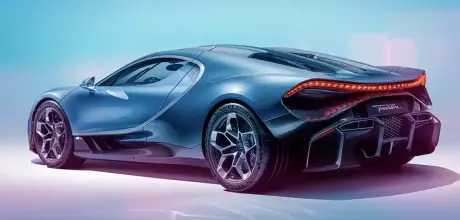2025 Bugatti Tourbillon
Excuse Mate Rimac’s language. He’s young, running Bugatti and passionate about the Tourbillon, his new baby – a 1775bhp hybrid with an 8.3-litre V16…
Words Ben Miller
Photography John Wycherley
Although it’s meant as a compliment it can so easily land like an insult. For ‘I was a huge fan of yours when I was a kid’, read ‘I’m really, really young – young in a way that you, in your middle age, can barely conceive of.’ Recently Griff, a singer, was announced as a support act for Taylor Swift’s massive Wembley show. ‘Eight-year-old me wouldn’t believe this!’ she gushed. ‘Taylor’s nearly old enough to be my mum!’ was an interpretation.

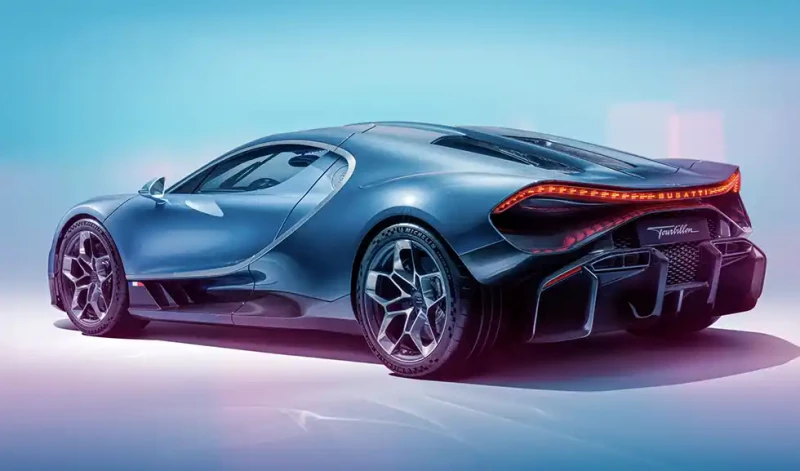
The eight-year-old Mate Rimac didn’t have a poster of the Bugatti Veyron on his bedroom wall because, outside of Ferdinand Pi.ch’s febrile imagination, the car did not exist. But just as soon as it did exist, he did. Who could have known that, two decades later and still only 36 years old, he’d be steering Bugatti, one of the most storied brands on the planet? (And it is one hell of a story: Hollywood/Netflix, if you’re reading this, let’s talk.) Well, Mate, probably: he’s that kind of individual.
A few milestones. After discovering a natural aptitude for technology and electronics, the young Mate converted a BMW to electric power. It quickly went from cute oddity to raging rocketship. In 2009, four years after the arrival of the production-spec Bugatti Veyron (987bhp and 253mph initially, together with the manners and refinement to drive to the opera) he founded Rimac Automobili. Back then Bugatti and Rimac were entirely discrete; one simply fired the youthful imagination of the other.
Having attracted big investment from the likes of Porsche, Kia and Hyundai, Rimac unveiled the Nevera, its second car, in 2018. Three years later, Mate became CEO of Bugatti Rimac, a new company. The Rimac Group owns 55 per cent, Porsche 45 per cent. As the name implies, it would concern itself with 21st century Bugatti’s third act – a car to succeed the Veyron and the conceptually similar Chiron. The direction of travel appeared obvious. Bugatti’s quad-turbo, 8.0-litre W16 ‘engine’ (petrol-fired power station feels more accurate) was on borrowed time. With control now in the hands of an EV-obsessed prodigy, that particular dinosaur’s asteroid was on its way, surely. Bugatti’s future would, inevitably, be BEV.

Except that it isn’t. Not yet, anyway. And potentially not ever. The new Bugatti, badged Tourbillon (in horology a mechanical device that increases accuracy, if you were wondering), is electrified but it is not electric. Cells and motors do nearly half the (very) heavy lifting. But the rest falls to a device that doesn’t feel real even as a I write these words: a new, clean-sheet engine displacing 8.3 litres and involving 16 cylinders, 64 valves and no turbochargers. Capable of revving to 9000rpm, it is good for a nice round 1000PS (or 986bhp, to which the hybrid drive adds another 789bhp). With its sweet, sweet music it is also capable of flooding your nervous system with a wild cocktail of adrenaline and dopamine in a way the Chiron – let alone the battery-electric Nevera – never could.
‘Early on there was a lot of discussion, particularly with the management, with Porsche. They were insistent the car had to be electric,’ explains Mate, grinning like a kid who’s not merely in the sweet shop but would appear to own most of it. ‘EV was the obvious and easy thing to do. With the Nevera I already had a 1900bhp electric hypercar. We could have easily transferred that technology or, as we showed with the [Pininfarina] Battista, re-skinned it – easy-peasy. But it was clear to me this was the wrong way for Bugatti.
‘I built an EV 15 years ago, but at Bugatti I had to fight like hell to do another combustion engine! I had all these people telling me I had no idea about emissions, about how hard it is to do a hybrid. But for me Bugatti must be at the top. I wanted to elevate it to a higher level. It comes back to the same words that drove [Romano] Artioli [orchestrator of Bugatti’s second age, in the early ’90s] and Piech: if it is comparable then it is not a Bugatti. It’s a simple sentence but a clear brief. A Bugatti has to be unique.’
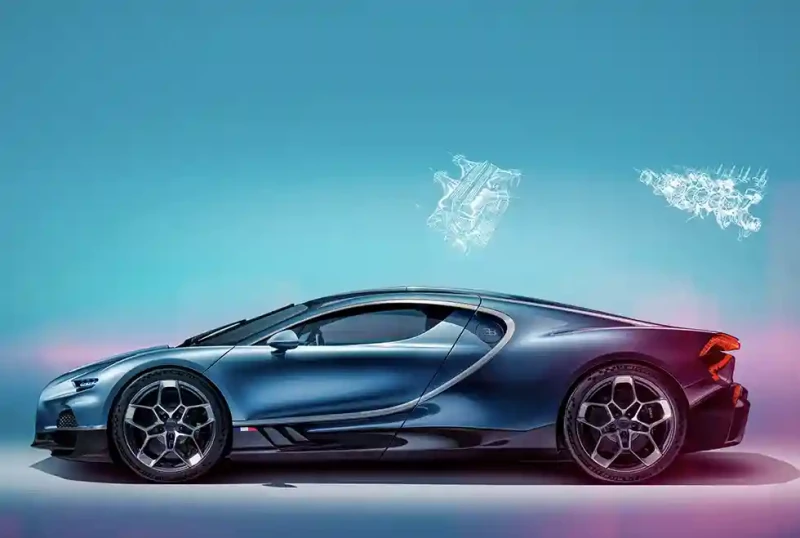
Body style, too, was up for grabs. While the Tourbillon is another two-seat hypercar, that wasn’t always a given. ‘These discussions were happening long before Bugatti Rimac, and we looked at every option; an electric coupe/SUV four-seater – which I killed immediately– a range-extender hybrid, a hybrid driving the wheels…’ continuesMate. ‘We talked to the owners too. Smart people. They told me the Chiron needed a successor; that Bugatti needed another hypercar. And the owners told me they wanted another combustion-engine. I decided to listen to the customers.’
Imagine that.
‘We couldn’t get more performance without going at least part-electric. We did look at adding electric power to the Chiron package.We could have removed the front differential, had the battery upfront, reduced the size of the fuel tank… But there were so many compromises. It was such a heavy solution. That’s when we looked at a clean-sheet design, which we laid down and of which we made a model. It was that model I presented to Herbert Diess [then VWGroup chairman]. That was in 2020. Three electric motors, a 28kWh battery and a naturally-aspirated V16 with a great sound. We want our engines to be raw, loud and powerful but they’re often heavily-turbocharged, and this detracts from the emotion. We wanted to rev to 9000rpm. So we have a completely new engine with additional performance from the EV powertrain, which also brings torque vectoring and four-wheel drive, but with the EV element very much in the background.’
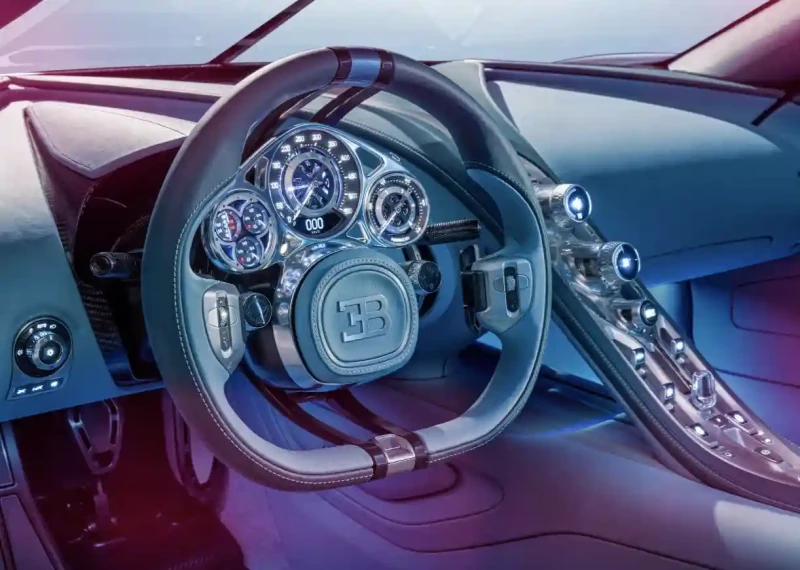
There is a new car to talk about, of course. But let’s get into that powertrain first. To do otherwise would be perverse. ‘We chose the hardest possible option – creating a new engine and pairing it with a complex system of motors, inverters, regenerative braking systems and more,’ chuckles CTO Emilio Scervo. ‘But we wanted the Tourbillon to retain the pure and raw analogue feel of a naturally-aspirated combustion engine. At its 9000rpm redline, under full throttle, the visceral experience is more intense than the Chiron.’
The engine weighs in at 252kg, some 150kg lighter than the old W16 – a clue to the subtle but significant shift in philosophy Mate has brought about at Molsheim. Deeply impressive but oddly anodyne to drive, the Veyron and Chiron were not touchy-feely cars. Their performance was also the product of brute force over drag, weight and the other downsides of rampant mechanical complexity. Mate’s firstBugatti is a little leaner (power is nearly 300bhp up on the Chiron but kerb weight is down), a little smarter (minimising drag was an obsession)and more emotionally resonant (an astonishing engine racket, plus more tactile steering), all while doubling down on the brand’s reputation for barely conceivable numbers: 0-62mph in two seconds flat, 0-124mph in less than five, 0-248mph in less than 25 seconds and 276.5mph, erm, where conditions permit.
The V16 features a 90° bank angle, 92mm x 78.55mm bore and stroke dimensions and a punchy 14.5:1 compression ratio that calls to mind the good old pre-turbo days. The vee angle brings sweet balance and the cross plane crank (versus a flat plane arrangement) a sense of near-limitless torque, not to mention ‘a very exciting power curve’ according Scervo. He’s ‘enjoyed’ long nights working to keep the engine’s size and weight in check.
‘We’re using an aluminium block and titanium conrods. It took a lot of honing and balancing work to get down from 270kg to more like 250kg.’ Scervo worked on helicopters and Alfa’s 8C before a seven- year stint at Ferrari, notably on the 458 Italia’s V8: ‘A very special naturally-aspirated engine and a beautiful experience. We changed everything.’

He also worked on the 720S and Speedtail at McLaren and spent three years with Aston. ‘The Bugatti’s gearbox here was born out of lessons I learned there. At Aston I worked with Graziano to develop a light, longitudinal gearbox that didn’t compromise the diffuser. When we came to do this car, we didn’t want a transverse gearbox like the Lamborghini [Revuelto], so I called Graziano again.’ The Lamborghini uses a transverse gearbox to keep the car from becoming longer than one of my sentences. The Bugatti, with its V16, faced the same challenge. ‘We worked with Cosworth, and it was a different working relationship. Traditionally you hand over your specifications and you get your engine. This was a collaboration. For example, when I joined in 2021 the bore size was big. A bigger bore gives you more revs and bigger valves for better breathing. But with eight big bores in a row you end up with an engine that is too long. So, I asked them to think again. We pushed hard on the cylinder-wall thickness, too, which is down to something like 7mm.’
And the V16 is only (just over) half the story, of course. It’s supported by three 250kW/335bhp electric motors, two on the front axle and one on the rear. The rear motor drives mostly though second gear, regardless of which gear the engine’s working with, but since e-motors are more efficient at higher revs, it only shifts up to fourth or sixth at very high speeds. The motors draw power from an oil-cooled, 800-volt 25kWh battery that’s integrated, together with its protective tray, into the all-new carbonfibre chassis structure, saving weight. Up front, the packaging might be nightmarishly complex but the entire front axle and all its sub-systems take up less space than the clart that occupied the front of the Chiron, marginally increasing luggage space. An 986bhp Tourbillon with no hybrid drive would be some 300-400kg lighter. Each motor weighs 22kg (the electric front axle assembly weighs 82kg), the inverters 11kg and the battery 175kg. ‘Hybrid is without doubt harder than pure combustion engine or battery electric. But the Nevera is the best there is when it comes to EV control systems, so a lot of that was applicable; management of the electric powertrain, torque vectoring, regen braking… And we’re still working on it. We still have 18 months to go.’
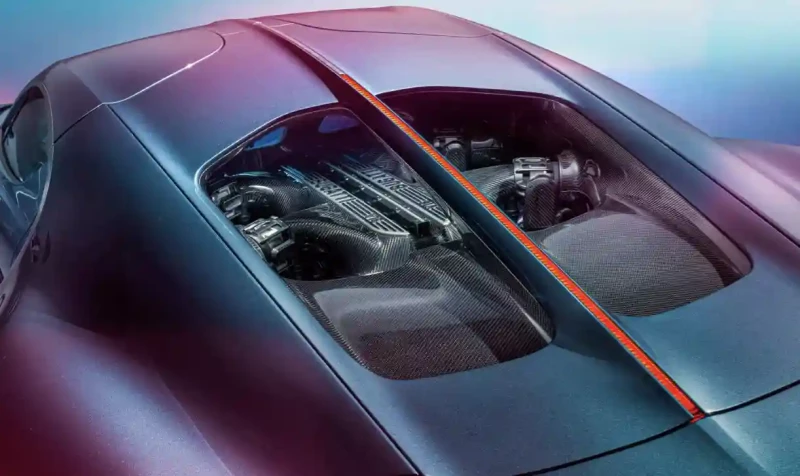
Just 250 units are being offered, at €3.8 million apiece. Production is due to start in 2026 and, as Mate acknowledges, ‘Bugatti has always delivered, delivered, delivered – this is not always the case in the hypercar world.’ Barring an act of God (not uncommon these days, granted) the Tourbillon is on its way.
And what of the timelessness fundamental to cars of this ilk – cars that, as Mate puts it, ‘must have an eternal quality’? Is that not impossible with electrified powertrains? ‘We saw some bad experiences with the so-called holy trinity [the McLaren P1, LaFerrari and Porsche 918 Spyder],’ says Mate. ‘But the most a Nevera has lost is five per cent capacity. We put a lot of effort on the management side into keeping it going for decades. The car works to protect itself, and if you really need to you can replace the battery.’
And the internal-combustion side of the equation? ‘I haven’t seen any legislation that prevents a combustion engine beyond 2035. We’re also hoping to offer synthetic fuel, so the owners can use these cars for a long, long time to come. And we’re talking about maybe 500 miles per year. These cars are used so little. It would be a shame to let go these works of art; these mechanical masterpieces.’
Picking over the Tourbillon with CTO Scervo and his opposite number on design, Frank Heyl, is not the work of a moment. Where the Chiron’s front suspension was double wishbone, the Tourbillon’s is multi-link, the better for negating the corrupting effect of all that power pouring through the front driveshafts. The upper suspension arms, 3D-printed in aluminium, are 45 per cent lighter than their steel Chiron counterparts. The strut brace is also 3D-printed, while the thin-walled, hollow-core shock-tower castings promise huge rigidity with low weight. The diffuser is vast, and starts at the passenger cell. Ordinarily, a transverse beam, previously considered essential to meeting rear-impact regs, would cut short the diffuser and ruin the airflow. Instead Bugatti has exceeded the required standards with an innovative, F1-inspired crash structure that delivers the required strength without desecrating the diffuser.
Mate: ‘It was a complete design philosophy – every part can be removed from the car and hung on the wall as art. I wanted to get every detail right and it’s so much harder and more expensive to change things later. For me the rolling chassis is a work of art. We pushed hard for real technical beauty, not just a nicely dressed-up package.’ You may consider the exterior design disappointingly evolutionary. I do. Wilder proposals were considered but rejected because, with the very clear design DNA that ran through Veyron and Chiron, Bugatti believes it has a Porsche 911 or Rolex Daytona on its hands. ‘Styling is not the most important thing,’ says Heyl. ‘If you think about each new iPhone, the perfect new iPhone has a better camera and more battery life and so on but you don’t want it to look different – you still want it to look like an iPhone. It’s the same with the Rolex Daytona. It is an icon, but for a development you don’t want the design to change. Maybe you just want a six-day power reserve rather than three. And you wouldn’t change the 911 for styling’s sake.’ Head admires the logic. Heart remains underwhelmed. Heart recovers again, though, on seeing the interior. You’ll recall the car’s name, and perhaps be tempted to consider its inspiration that spectacular engine. But there are equally awe-inspiring mechanisms inside the car, including analogue instrumentation inspired by luxury watches and a fixed-hub steering wheel. And there are no permanent screens. Mate: ‘We wanted to create something that wouldn’t date even though we are trapped in the technology of our time.’
The instruments comprise more than 600 parts (some in titanium; others in gemstones), weigh just 700g (less than half that of their digital equivalent, Mate insists) and work with the kind of eerie precision that comes of tolerances as fine as five microns. The speedometer’s mechatronic assembly alone comprises 250 parts.
‘We wanted to keep the value in the car, and to countersteer the trend of the industry,’ explains Mate. ‘In a digital world of more and more screens you all converge on the same thing. Also, screens and digitisation have democratised technology – a billionaire cannot have a better iPhone than a 14-year-old kid.’
You gaze at the clocks through the wheel, the instruments apparently floating – wobble-free thanks to bearings and two fiendishly complex pairs of gearsets – upon the steering column. Such systems have been done before, of course, but not while retaining the direct connection to the steering shaft crucial for feel. Scervo in particular talks again and again of this being a less aloof driving machine than its predecessors.
‘You have the same comfort as the Chiron but with more steering feel and feedback. It’s progressive, too. As you reach the slip limit of the tyres you feel it – Chiron didn’t have that. We also have faster lateral responses thanks to a lower centre of gravity, by 25mm. And thinking about the longer term we have a lot of potential within this chassis.’ Scervo’s hinting at a sportier version; Mate, meanwhile, doesn’t confirm a front-engined Royale reboot, with the V16 in its nose, but neither does he rule it out. Talking with the euphoria of an artist who’s just finished what they already know to be their life’s work, Mate doesn’t fight back the emotion. ‘I wanted to show how beautiful things built by humanity can be. There’s an eternal quality to cars like these. They will never be scrapped or recycled; they will live forever. And normally you start with all these big ideas and then, as you run out of time and money and talent, it all deteriorates. Not here. The naturally-aspirated V16 engine, the pop-out screen, the Swiss-watch instruments… We f***ing did it all.’
With the clear design DNA that ran through Veyron and Chiron, Bugatti believes it has a Porsche 911 or Rolex Daytona on its hands
Mechanical, watch-inspired instruments are glorious madness Spine long a Bugatti feature; the V16 beneath. Huge downforce and less drag than the Chiron. There is one small pop-out screen, if you really want.
250 units are being offered at €3.8 million apiece, with production due to start in 2026
Mate’s first Bugatti is leaner, smarter and more emotionally resonant, all while doubling down on the brand’s USP: barely conceivable Numbers.
A new 8.3-litre engine with 16 cylinders, 64 valves and no turbochargers Vaguely McLaren P1-inspired rear end features avast diffuse.
Recognisably aBugatti – almost disappointingly so, given what lies beneath…
BUGATTI IN CAR THREE DAYS WITH THE VEYRON, SEPTEMBER 2006
It remains one of the most inspired covers in more than 60 years of CAR– a starkly lit double garage, a random ladder and, right there, a Bugatti Veyron. Equally inspired was the headline – ‘Right car, wrong planet’ and the story, a postcard from another world as European editor Georg Kacher triedto make sense of it all.
FLAT-OUT IN THE CHIRON, OCTOBER 2016
2016 and Georg is at it again, wrangling a ride in the box-fresh Chiron with then CEO Wolfgang Dürheimer (the man’sCV also includes Porsche’s Carrera GT and 918 Spyder – ridiculous). Together the two of them put the car’s 1479bhp and 1180lb ft to good use, regularly messing about at speeds in excess of200mph and terrifying a long line of other road users.
INSIDE BUGATTI HQ, MAY 2015
Skip forward to 2015 and Bugatti’s gearing up for the Veyron’s successor. We visit for a day of exquisite snacks, unrivalled access and a chance to checkout the final Veyron, the very red LaFinale. We also scoop the car that would become Chiron, nailing the numbers while getting the look of the thing completely wrong.
CENTODIECI, EB110 AND THE LOST ERA, OCTOBER 2019
The best looking modern Bugatti yet, the Centodieci, riffed heavily on the EB110, the enigmatic product of Bugatti’s Artioli years. We got the two cars together not in some cold, anodyne studio space but in the decayingspl end our of the Modena plant, a factory that time forgot, complete with swarf still on the floor from the machining of the EB’s V12 engine.


